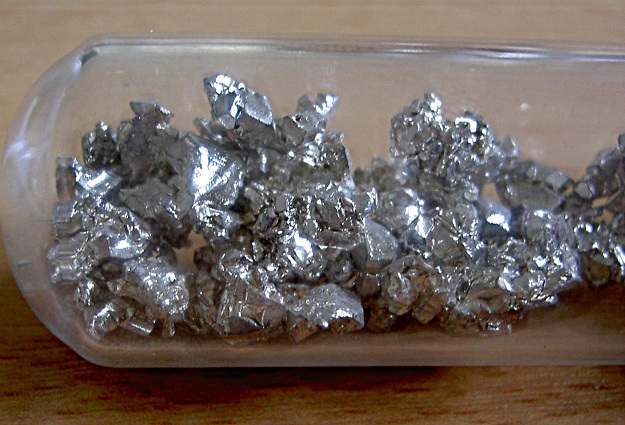As I noted last week in Of Minerals and Men, the journal Nature recently reported that the concentration of mercury in the upper zone of the world’s oceans has more than tripled since the start of the Industrial Revolution. I found this to be a rather troubling statistic, and decided to delve into it a bit further. Let’s work through some of the key questions raised by the Nature report.
Where Does Mercury Come From?
While we are all familiar with the image of mercury as a shiny liquid, this is not how mercury commonly exists in the world. Like most other metals, such as copper, iron, or gold, mercury is found in underground ore deposits in which it is chemically bound to other elements. The most common type of mercury-containing ore consists primarily of mercury sulfide and is called cinnabar. To produce pure mercury, you need to dig up some cinnabar and execute a rather complex purification process.
How Does Mercury Get into the Oceans?
There are two primary mechanisms by which mercury is introduced into the biosphere. About half of the mercury which reaches the soil or oceans comes from volcanic eruptions. The temperature of the lava is high enough to extract pure mercury from cinnabar, and then an eruption ejects tiny mercury droplets into the air which eventually settle on the land and water. The remainder of the mercury in the biosphere has been introduced by humans, with the majority coming from coal-burning power plants. Since coal contains a small amount of mercury, burning it to generate electricity emits some mercury into the air.
As I will explain below, the mercury which falls in the oceans represents a far greater health risk compared to that which falls on the ground.
Why is Mercury Poisonous?
The background for the answer to this question was contained in last week’s column, Of Minerals and Men, which explained why the proper functioning of the human body is dependent on the action of metal-containing enzymes. Of particular interest to us this week are enzymes which contain selenium metal. There are 25 different types of selenium-containing enzymes in the body which perform a broad range of vital services, including protecting the brain from oxidative damage. Since mercury reacts rapidly with selenium, when it enters your bloodstream it immediately begins to shut down the proper functioning of your selenium enzymes. This can result in brain damage, kidney dysfunction, nerve damage, high blood pressure, rapid heartbeat, and, in extreme cases, death.
How Does Mercury Enter the Bloodstream?
Mercury used to be present in many common household devices such as thermometers and thermostats. When we became aware of the dangers of mercury during the 1970s, these devices were replaced with non-mercury-containing substitutes. Liquid mercury, as from a broken thermometer, presents very little hazard to people. At room temperature, mercury’s vapor pressure is so low that there are essentially no vapors to inhale. Furthermore, if even if you were to drink liquid mercury, your body will absorb only 0.01% of it. This explains why people in industrial and laboratory jobs, who routinely spilled mercury on themselves in the pre-1970 era, did not die of mercury poisoning.
Ironically, attempts to clean a mercury spill can introduce far greater hazards than the spill itself. For example, if you were to try to use a vacuum cleaner on a mercury spill, you would likely create an aerosol of mercury droplets coming out of the vacuum cleaner exhaust. This could result in your inhaling mercury droplets into your lungs where 80% of them will enter the blood stream. Although, this can be a hazardous situation, household and work place mercury spills are rare events these days.
The primary pathway for mercury to enter the human body is through the consumption of fish. When mercury metal is deposited in the oceans, bacteria convert some of it to a compound called methyl mercury. The methyl mercury is then absorbed by algae, which is eaten by small fish, which are eaten by bigger fish, which are eaten by even bigger fish, and so on. By the time you get to the top of the food chain, with large, long-lived fish such as tuna or swordfish, the concentration of mercury in their flesh can be well above levels recommended for safe human consumption. This process is known as bioaccumulation or biomagnifications. There is no equivalent bioaccumulation process related to mercury which falls on the ground; hence, the focus of both the Nature article and this column, on the oceans.
What Does this All Mean?
Both the United States Environmental Protection Agency (EPA) and the World Health Organization (WHO) have established daily limits for mercury consumption. However, because mercury that you eat stays in your body for a long time, longer-term dietary habits are a more important parameter than daily intake when consider health risks. People who eat a lot of fish accumulate mercury in their bodies over time. A correlation has been developed which shows that if your daily consumption of mercury matched the EPA limit that your hair would contain 1.2 parts-per-million (ppm) of mercury and if you consumed the WHO limit it would be 1.8 ppm. Many people in countries such as Spain, Indonesia, and Thailand, where fish is a prominent feature in the national diet, have more than 1.8 ppm of mercury in their hair. Closer to home, a recent survey of residents of Pensacola, Florida showed that 15% of residents had more than 1.2 ppm of mercury in their hair.
Since both the burning of coal and the consumption of fish continue to rise, we can expect that the average concentration of mercury in our bodies will as well. Because this increase has been and will be slow and because the effects of mercury on the body are multifaceted, it will be difficult to parse out the implications of this for some time. However, there are already some troubling signs. For example, I came across a credible, peer-reviewed article correlating higher concentrations of mercury in their hair to lower sperm counts for men in Hong Kong.
I find the growing concentration of mercury in the oceans to be yet another reminder that the human population of seven billion is beyond the long-term carrying capacity of the earth. While there is not much you can personally do to impact the global population problem, there is something you can do to protect yourself from mercury poisoning, become a vegetarian.
Have a comment or question? Use the interface below or send me an email to commonscience@chapelboro.com. Think that this column includes important points that others should consider? Send out a link on Facebook or Twitter. Want more Common Science? Follow me on Twitter on @Commonscience.





Comments on Chapelboro are moderated according to our Community Guidelines